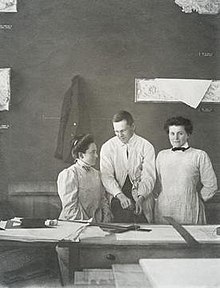Elisabeth von Knobelsdorff
Elisabeth von Knobelsdorff | |
|---|---|
 | |
| Alma mater | |
| Occupation | Architect |
Elisabeth von Knobelsdorff (17 June 1877 Potsdam – 20 April 1959 Bassum) was a German engineer, and architect.
Early life[edit]
Her parents were the Major General Heinrich Wilhelm Kurt von Knobelsdorff (born 13 April 1850) and Marie Elizabeth Fancis Gertrud Dyhrenfurth (born 17 September 1856).
Education[edit]
In 1906, Elisabeth von Knobelsdorff graduated from the Munich Realgymnasium. In 1907, she began studying architecture at the TH Charlottenburg, first as a guest student, after the admission of women at the universities in the Kingdom of Prussia in 1909. She finished her studies in 1911, as the first woman in Germany with the diploma in engineering.[1]
Career[edit]
In 1912, she became the first female member of the Association of Architects and Engineers in Berlin (AIV) and took part in the exhibition "The Woman in Home and Work", a showcase of the women's movement.[2] The organizers of this exhibition included her aunt Gertrud Dyrenfurth (1862-1946), who lived on the estate of the family in Jakobsdorf near Wroclaw. Elisabeth von Knobelsdorff designed a community center for the Silesian village, which was built in 1915.[3] It remained until 1946, the social center of Jakobsdorf.
In World War I, she worked as a "field architect in the rank of lieutenant" in the military building administration in Doberitz near Potsdam, and at the German Army High Command in occupied Belgium.[4][5] After World War I, she worked as an architect at the provincial government in Potsdam. In 1921, she passed the state examination for the building authority, and was again appointed as the first woman in Germany, master builder for the government.
In 1922, she married Kurt Wilhelm Viktor von Tippelskirch, Legation manager in the Foreign Office, and was then released in 1923 (as married) from the civil service. She then worked freelance as an architect in Berlin-Charlottenburg, until she accompanied her husband to the United States in 1927.
After returning in 1938, the couple lived in Jakobsdorf, from where she was expelled at the end of World War II. Elisabeth von Knobelsdorff lived in Bassum near Bremen from 1946 until her death in 1959.[6]
References[edit]
- ^ "Ingenieurkammer Niedersachsen – Studierende". www.ingenieurkammer.de. Retrieved 2017-12-26.
- ^ Bingaman, Amy; Sanders, Lise; Zorach, Rebecca (2003-12-16). Embodied Utopias: Gender, Social Change and the Modern Metropolis. Routledge. ISBN 978-1-134-53756-3.
- ^ Stratigakos, Despina (2008). A Women's Berlin: Building the Modern City. U of Minnesota Press. ISBN 978-0-8166-5322-5.
- ^ Brown, Lori A. (2016-04-15). Feminist Practices: Interdisciplinary Approaches to Women in Architecture. Routledge. ISBN 978-1-317-13563-0.
- ^ Boak, Helen (2015-11-01). Women in the Weimar Republic. Oxford University Press. ISBN 978-1-5261-0162-4.
- ^ "Die erste Studentin: Elisabeth von Knobelsdorff (1877–1959)". archiv.pressestelle.tu-berlin.de. Retrieved 2017-12-26.
External links[edit]
![]() This article incorporates text available under the CC BY-SA 3.0 license.
This article incorporates text available under the CC BY-SA 3.0 license.


 French
French Deutsch
Deutsch